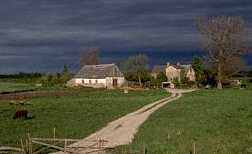|
The AINO Tablets of Latvia
|
 Stig Viksne and tablet #15 at Estonian fair in 1932
Stig Viksne and tablet #15 at Estonian fair in 1932
|
THE DISCOVERY OF THE AINO TABLETS.
In 1922 on a Latvian farmstead south of the town of Liepaja, a remarkable discovery was made by a local farmhand. While plowing a field, Istvan Kogalniceanu discovered several flat stones under the dirt and he dug them up. What he discovered were 207 stone tablets upon which were carved strange characters which he could not read. The stones all appeared to have been cut from one larger rock. Kogalniceanu carted the tablets into a storage shed where they were eventually forgotten. A few years later, the owner of the farm, Stig Viksne, used the stones for a fence along the perimeter of his property. Word of the tablets eventually made it to Riga and the newly renamed University of Latvia (formerly the Latvian Higher Education School).
Around 1927 or 1928, the tablets were shipped to the university where undergraduates transcribed all of the runes on the stones and began the arduous task at deciphering them. The runes were similar in fashion to Norse runes, but it was determined that the language that the tablets were written in was not related. Few breakthroughs were made at deciphering the stones, and Viksne eventually retrieved the tablets before the stones were to be shipped to Moscow.
Viksne's stones gained some interest locally and he displayed them at a fair in neighboring Estonia in 1932 (conflicting accounts place the fair at Sauga or Parnu-Jaagupi, both near the city of Parnu). Viksne died in 1934 and the stones were soon forgotten, sitting crated in the storage shed on his farm. The farm changed hands and its new owner, Agris Mickus, soon discovered the stones in the shed. Despite the fact that Latvian farmers were enamored by Karlis Ulmanis and his new totalitarian regime, Mickus decided to immigrate to the United States. He became a U.S. citizen in 1940 just weeks before Soviet occupation of Latvia on June 17, 1940. Unfortunately Mickus had not placed much importance on the crates of tablets in the farm shed, and he did not have them shipped to the U.S.
After World War II broke out, the tablets once again served the purpose for a stone wall on the farm. Little information has been found about what transpired on the farmstead between 1940 and 1951, but Agris Mickus, who had spoken of the stones to associates in the U.S. decided to try to reclaim the tablets. He was unsuccessful as the shed had been razed and the stones were missing; however, Mickus was able to retrieve the written transcriptions of the stones that had been made in the late 20s at the University of Latvia.
Mickus, who had no training in translating languages, had no more success than the students of the University of Latvia had at deciphering the runes. Eventually he forgot about the stones and the transcripts. Agris Mickus died 1952 at age 73 on his farm in central Missouri. The same month, the stones in Latvia had been recovered. Once again they had found themselves as part of a stone wall separating fields on the farm. The tablets were boxed up and shipped to the U.S. and put in storage with the rest of Mickus's belongings. Having no children or heirs, the tablets sat in storage in Columbia, Missouri for almost half a century.
|
 Latvian farmstead near where the tablets were unearthed
Latvian farmstead near where the tablets were unearthed
|
NEW DISCOVERY OF AN ANCIENT CULTURE IN EUROPE?
In August of 1998, the estate of Mickus was sold to the general public, and a Thomas A. Lack purchased all of the Latvian tablets. The transcript of the stone's runes, however, had found their way into the possession of a former neighbor of Mickus. Tracking down the stones and the transcript was a student of archaeology, Alan Trupnow, who had heard about the stones during an expedition in Estonia. Trupnow attempted to view the tablets that now were owned by Lack, but the young college student was turned away. Trupnow bought the transcript from Mickus's neighbor for twenty dollars and a cheap watch.
Trupnow, although an avid language buff, was not formally trained in translating or deciphering. However, by early the next year, Trupnow had singlehandedly deciphered the entire alphabet of runes from the tablets, and had made considerable progress translating the text. Once the translation of the first two tablets was complete in February of 2000, Trupnow once again sought out Mr. Lack in hopes of examining the stones. For after Trupnow saw what the tablets meant, he was determined to prove that they were a hoax. Lack was not to be found, nor the stones, and Trupnow failed to relocate the man who had purchased the tablets.
Trupnow decided that if the tablets were authentic, he had stumbled upon perhaps one of the greatest archeological discoveries of Europe. If it was a hoax, he was still intrigued at its purpose. Why would anybody painstakingly carve 207 tablets in an unknown alphabet and language describing a diverse mythology of an up-to-now unheard of culture in northern Europe?
You are visitor #     
This site is in no way affiliated with the University of Missouri
The Aino site is owned and maintained by Kendal Selle |
|